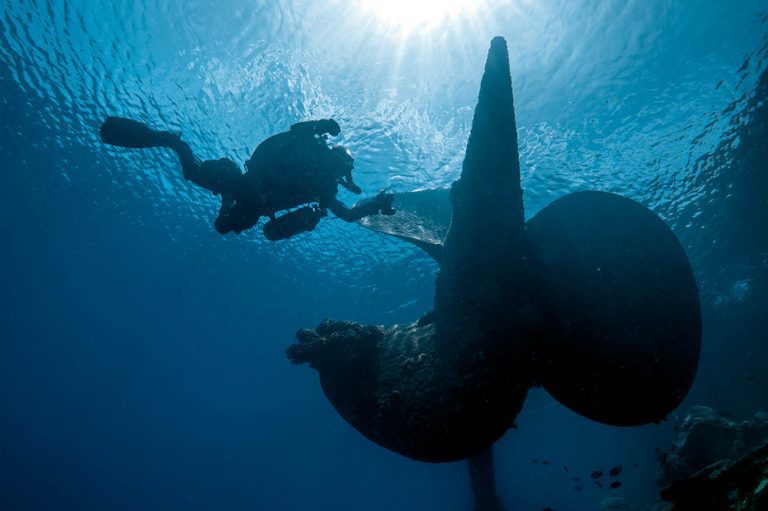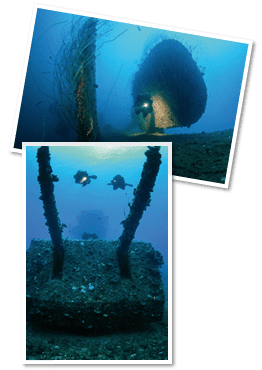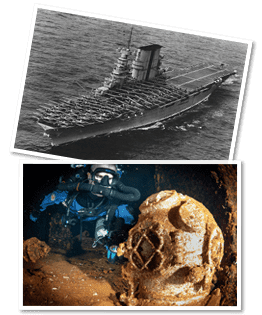For the good of mankind and to end all world wars, that was the premise: JESPER KJØLLER reviews the awful and awesome legacy of the USA’s Operation Crossroads
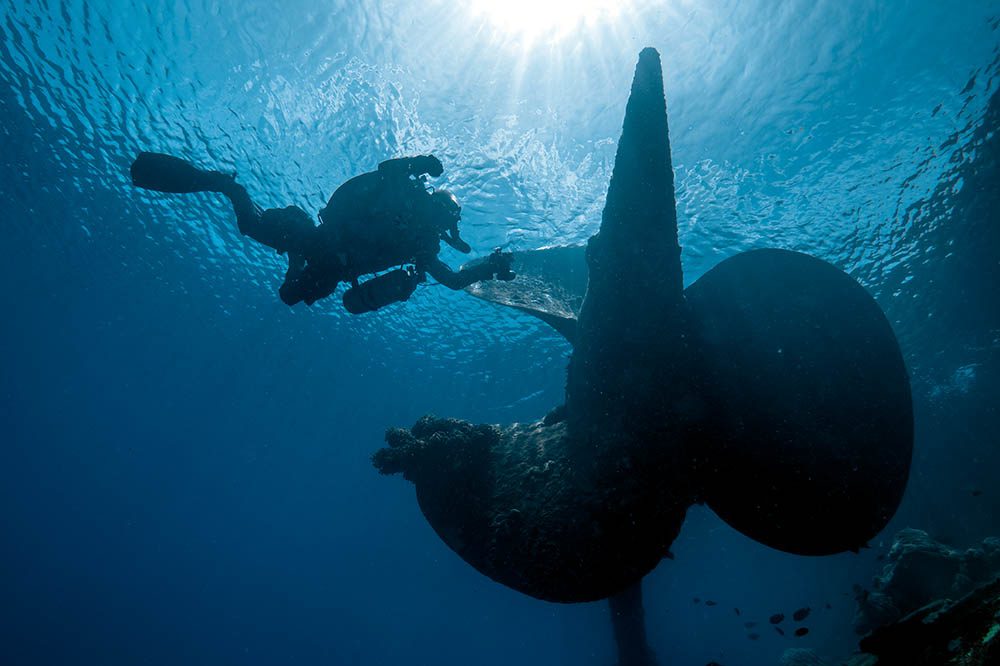
Prinz Eugen’s props.
Imagine a knock on the door. A friendly man on your doorstep tries to convince you to pack everything and leave home. Not just you and your family, but your entire community. It is for the good of mankind and it will end all world wars, he claims.
Would you agree? Would you accept the offer to be moved far from the only place you ever knew? And would you be happy to discover that the relocation, far from temporary, would last several generations?
And that you would probably die a slow, gruesome death if you ever returned home?
This is exactly what happened in February 1946, when US military governor Ben H Wyatt persuaded local chief King Juda to convince his people to evacuate their small island in the Bikini Atoll.
The population of 167 was moved to cramped barracks on a remote island, and preparations for a nuclear-testing programme began. Operation Crossroads was go!
Bikini Atoll was chosen as a test area primarily for its remoteness, which is why we have to endure a long and sometimes challenging journey to get there today. After almost three days, we feel as if we’ve travelled to the opposite side of the globe, and indeed we are almost on the dateline – 12 time zones from the Greenwich Meridian.
Bikini lies just north of the Equator in the Pacific Ocean halfway between Australia and Hawaii, and consists of 23 islands, of which only two were
ever habitable.
After three other stops, the United Airlines Island Hopper from Guam finally drops us at the US army base at Kwajalein Atoll. There follows a short free ride on a military ferry to the small, densely populated civilian island of Ebeye. We nurse our jet lag for a day at the charming and rustic Hotel Ebeye, the only one in town, before boarding Truk Master.
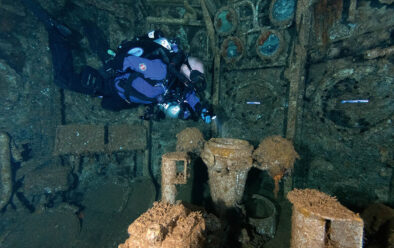
Before beginning our 24-hour cruise north we have time for a dive on the heavy cruiser Prinz Eugen. The German vessel was impounded by Allied forces after WW2, and German and Japanese target ships were included in the nuclear tests to investigate any meaningful differences in enemy shipbuilding methods in respect of damage from atomic weapons.
Prinz Eugen survived both Operation Crossroads blasts with only minor structural damage, but received a large dose of radioactive fallout.
Later that year she was towed to Kwajalein Atoll for decontamination and offloading of ammunition, but leaks she had sustained could not be repaired because of the radioactivity, so in December 1946 she was capsized in shallow waters in the lagoon.
As with most heavily armoured warships Prinz Eugen lies inverted, but the wreck remains an epic dive and its scale primes us for what lies ahead.
Main photographic attraction are the three gigantic propellers, one of which protrudes from the water.
Bikini Atoll appears on the horizon late the following afternoon. We have made good time on the unusually calm Pacific Ocean and arrive a few hours earlier than expected, so are able to get in a quick orientation dive on the USS Saratoga. Probably the largest diveable shipwreck in the world, it is among the very few aircraft-carriers accessible to divers.
Swimming towards the descent line at Truk Master’s bow I look down, and it dawns on me that what I see below is not the bottom, but the flight deck of the 270m carrier!
We descend to the deck at around 30m to get our bearings. The entire flight-deck is covered by teak planks, chosen because they were solid and easy to repair.
Despite a layer of seaweed and corals it remains possible to make out individual planks here and there.
To give the pilots as much space as possible for take-offs and landings, aircraft-carriers have a tall, narrow bridge set to one side. Saratoga had four sets of 55-calibre MK9 8in double-barrelled guns, two pointing forward and two pointing aft, but only one of the turrets was left before the blast, and the smokestack has since collapsed.
The superstructure is, however, surprisingly intact. We find map, radar, coding and radio rooms, all very small and cramped.
We swim into the wheelhouse. It has no windows, only narrow slits, presumably to protect officers in their high, exposed position. Ahead of the wheelhouse is an outside navigating bridge, from where they would have a better view of the ship and its surroundings when manoeuvring.
We swim towards the upline to begin our decompression. Having stayed relatively shallow, we have racked up more than 30 minutes of deco. Suddenly my buddy points behind me and I turn.
A tiger shark is checking us out and stays for a while. We later hear that he is a common sight on the Sara – the icing on our cake.
We study a selection of blueprints and schematics of the wreck closely between dives to ensure that we visit interesting places in the most efficient manner. An aircraft-carrier is a floating city, and when fully operational USS Saratoga housed some 2800 crew.
Compartments marked include a bakery, barber shop, dentist, laundry, sickbay, blacksmith, potato-peeling room, butcher and dive-locker. Exciting stuff!
You could easily go to Bikini and dive only USS Saratoga for a week. In fact if this was the only wreck it would still be worth the trip. We did five long dives on the enormous vessel and I still felt we had only scratched the surface.
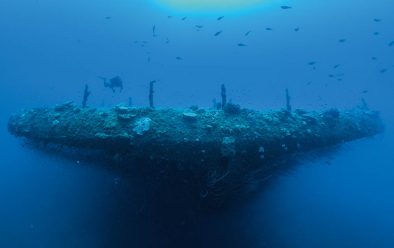
Theoretically there are several kilometres of passageways to explore, though not all levels are accessible or safe to penetrate. But from the huge forward aircraft elevator various routes are possible. A doorway invites, but beyond it looks very silty and hazy, so we deploy a safety spool and tie off first.
After swimming past the first couple of rooms the visibility opens up. We can now see the permanent penetration-line that leads further into the wreck, apparently laid by staff from the now-defunct dive-centre at Bikini Island.
We attach our safety-line to the mainline. Everything is very rusty and the floor is covered by a thick layer of extremely fine sediment. One careless hand-movement or misplaced fin-kick will destroy the visibility.
Open-circuit exhaust bubbles would dislodge a shower of rusty particles from the roof here.
We’re using JJ rebreathers, but it’s still necessary to adjust buoyancy once in a while, and even a small stream of bubbles from a mask provokes percolation.
The trick is to move very slowly and deliberately. I’m hindered by my big camera system, and for every doorway or bulkhead we pass, I have to fold the strobe arms and cautiously push the camera in front of me while taking extra care not to scratch the dome.
After only a few minutes, we find the first Easter egg. On the floor sits a US Navy Mark V diving helmet in very good shape. The original design was from 1916, but the 30kg helmet was still in use in the mid-1980s. The remaining presence of this very valuable collector’s item speaks volumes of the limited number of divers that have visited Bikini.
From the maps we know that after swimming down a flight of stairs we need to make a sharp right turn to reach our destination. My buddy on all the dives in Bikini, the famed wreck-explorer Richard Lundgren, swims ahead of me in the narrow passageway and suddenly disappears into a doorway to the left.
Is this it? Did he find it?
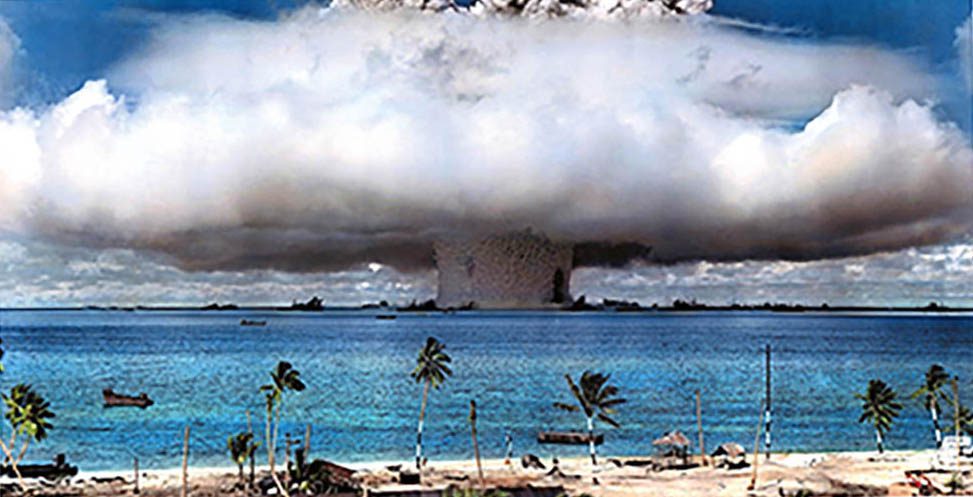
OPERATION CROSSROADS
_Operation Crossroads was the codename for the US nuclear weapon tests conducted at Bikini Atoll in July 1946 – the first detonations of nuclear devices since Hiroshima and Nagasaki the previous year.
_President Truman ordered his generals “to determine the effect of atomic bombs on American warships” but many historians agree that the Americans’ hidden agenda was to flex their nuclear muscles to deter the emerging Eastern Bloc superpower.
_In preparation for the test programme 242 naval vessels, 156 aircraft, 25,000 radiation devices and thousands of experimental rats, goats, and pigs were put in place. The operation involved 42,000 military and civilian personnel.
_The Crossroads series were the first of many nuclear tests conducted in the Marshall Islands and the first to be publicly announced beforehand and observed by an invited audience, including a large press presence, which supported the hidden-agenda theory.
_The target fleet was hit with two sets of plutonium implosion-type nuclear weapons of the type dropped over Japan, each with a yield of 23 kilotons of TNT. The first test, codenamed Able, was dropped from a B-29 Superfortress on 1 July but detonated 158m above the fleet, causing less damage than expected as it missed its aim point by 649m.
_The second test, Baker, was detonated 27m under water on 25 July, and radioactive sea-spray caused extensive contamination. A third deepwater test named Charlie planned for 1947 was cancelled, primarily because of the US Navy’s inability to decontaminate the target ships after Baker.
Yes, we have found it – the dental operation room. Everything is intact: three dentist chairs complete with drills, rinse-bowls, hoses and lights. We move very carefully inside the small compartment to avoid destroying the delicate environment or stirring up any silt.
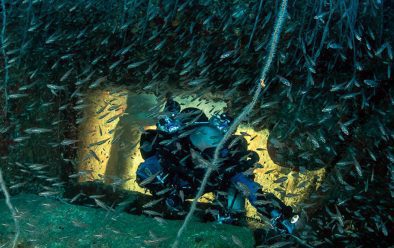
On the way back we spot more hidden gems, such as wall-mounted telephones, fire extinguishers and sickbay signs. Old-school Coca-Cola bottles are scattered all over the place.
In many rooms and corridors we see filing cabinets. In the pre-digital age the Navy had a lot of paperwork to store.
On a later dive we find the dive-locker, complete with umbilical hoses and hanging drysuits, and explore crew lounges with sofas and coffee-tables.
Allegedly no one has explored the engine-room yet. Towards the end of our last dive on the Saratoga we find a possible way in, but have run out of time, so leave Sara with a sense of unfinished business.
All the warships in the lagoon played important roles in WW2 history around the world, but the one with the most impressive historic pedigree has to be the Japanese battleship HIJMS Nagato.
It was from this floating fortress that Admiral Isoroku Yamamoto directed the attack on Pearl Harbor on 7 December, 1941. Nagato was impounded by the Americans after the Japanese surrender, and I suspect that the opportunity to avenge Pearl Harbor played a role in the decision to include her in Operation Crossroads. Nuke the Nagato!
As with Prinz Eugen, the inverted Nagato’s highlights are the enormous propellers, four of them, and her twin 16in guns, which were the biggest in the world at the time.
The pagoda-style superstructure is partly squashed under the weight of the hull, but it is possible to squeeze into the bridge and pretend you’re Admiral Yamamoto listening to the famous radio codeword Tora! Tora! Tora!, said to have been the signal to commence the Pearl Harbor attack.
Yamamoto had been against attacking the US base in Hawaii because he feared it would bring the Americans into the war. His alleged post-strike prophecy, “I fear all we have done is to awaken a sleeping giant and fill him with terrible resolve”, turned out to be famous last words…
The responsible Truk Master crew recommend reducing the intensive diving activities mid-trip to off-gas a little, so instead of an afternoon dive we explore Bikini Island. A walk of a couple of kilometres brings us to the small settlement that until 10 years ago hosted Bikini Atoll Divers, opened in June 1996 and run by the Bikini Atoll Council.
The plan was to provide an economic base for a possible future resettlement of the island, but in 2008 the council had to shut down the operation, the result of local airline reliability issues combined with soaring energy costs and world economic decline that also hit dive tourism.
The dive staff were stranded on the island for a month when the plane that was meant to evacuate them broke down.
The area has an unnerving post-apocalyptic atmosphere, and it’s clear that everyone left in a hurry when a boat finally showed up. The last dive-briefing can still be seen on the whiteboard in the dive-centre, and in another building dive-gear, spare parts, compressors, service-room, rinse-tanks and everything else remains as it was abandoned – spooky.
The size, history and the details of the Saratoga and the Nagato make these wrecks the crown jewels – not only on a Bikini scale, but anywhere in the world – but we also take the chance to dive a handful of destroyer, battleship and submarine wrecks from Operation Crossroads. My absolute favorite among those “smaller” vessels (everything is small compared to Saratoga and Nagato) is the destroyer USS Lamson.
We descend along the mooring-line to a pleasant surprise, because Lamson sits upright on the sandy bottom, and visibility is the best we have seen in Bikini so far. Lamson was armed to the teeth when she was sunk and is full of artillery, cannon, deck-guns and racked mines, depth-charges and torpedoes.
The mid-section is just a big twisted and mangled area. Beside the wreck on the sand at 50m I spot a sleeping whitetip reef shark and approach it cautiously from one side while Richard positions himself on the other side.
With my 15mm fisheye lens everything looks small from a distance, but the silence of our rebreathers is a giant advantage, and I manage to move very close before the shark wakes up and swims away irritably.
I’ve been fortunate enough to dive some of the world’s most iconic shipwrecks, such as Umbria, Thistlegorm, Britannic and the wrecks of Truk Lagoon, but the Bikini experience is in a league of its own. It feels very meaningful to be able to document the history of this place, not only the war records of all the wrecks, but also the impact on nature and the population of the Truman administration’s decisions.

TRUK MASTER & CRITICAL EXPERIMENT
_Truk Master spends July to October in Bikini every year. Master Liveaboards has been the only regular scheduled dive-operator there since the dive-centre was abandoned.
_The vessel’s four decks provide ample space for relaxation, dive-equipment and camera preparation, and it caters for tec-divers on open and closed circuit. It carries twin oxygen-makers, an ample supply of helium, twin-sets, rebreather- and deco-tanks and scooters for rental.
_It is a huge challenge to run a liveaboard operation when everything has to be shipped from far away, but the Truk Master crew make it look very easy, and you almost forget how far from civilization you are.
_Throughout 2019, 2020 and 2021 wreck-explorer Aron Arngrímsson is hosting a series of expedition-style trips with Truk Master exclusively for technical CCR divers– Dirty Dozen trips in Truk and Critical Experiment trips in Bikini – email info@thedirtydozen.org
The banishing of the people of Bikini is ongoing, because radiation still prevents permanent sustenance-living there, and the wrecks themselves are a ticking time-bomb.
Many were fuelled to 80% capacity, and that fuel will eventually escape as the wrecks disintegrate. This potential environmental disaster of Exxon Valdez magnitude is not a matter of if but when.
The diving is relatively easy, with only weak or no current. Most of the wrecks lie outside recreational limits and divers with rebreathers and decompression skills can explore a lot more of them by being able to go deeper and stay there for longer.
Visibility varies from wreck to wreck and seasonally but is usually quite good. A full 3mm wetsuit is sufficient, though most technical divers will use drysuits as we did, and wear gloves and a hood for protection, especially when doing penetrations.
Most wrecks are at 50m, and we usually did 60-minute dives with 60 minutes’ deco, but the stops are very pleasant, with a solid deco bar as support on the final ones. The long runtimes on a rebreather limit the number of daily dives to a morning and an afternoon dive. Truk Master enforces a mandatory and sensible minimum surface interval of four hours between technical dives.
If you are a serious wreck-diver, make plans to go to Bikini, whatever it takes. With Aron Arngrímsson’s Critical Experiment expeditions in partnership with the Truk Master, it has never been more fun to explore Bikini’s nuclear fleet. Just be prepared to wait your turn!
FACTFILE
GETTING THERE> United Airlines operates two routes to Kwajalein, one from Guam and one from Honolulu. From the UK Honolulu is the shortest option, but both it and Guam require US ESTA clearance. Kwajalein is a US army base, so a sponsor letter from the tour operator is required.
DIVING & ACCOMMODATION> Truk Master (see panel above), masterliveaboards.com
WHEN TO GO> Dry season is December-April; the wet season May-November. The weather changes all the time, but though it can rain heavily it is often only for short periods. The climate is stable, hot and humid, with both water and air temperatures of 29-30°C year-round.
MONEY> US dollar.
HEALTH> There is no chance of recompression therapy in the Marshall Islands. Serious DCI problems require evacuation to Guam or Honolulu, so ensure that your diving insurance covers emergency evacuation.
PRICES> There are few spaces available now for the next few years so it’s difficult to give an exact price, but for a 10-night itinerary in 2021 reckon on £8500-10,000 including flights! Talk to blue o two, blueotwo.com
VISITOR Information> visitmarshallislands.org
